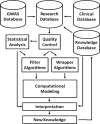Bioinformatics challenges for genome-wide association studies
- PMID: 20053841
- PMCID: PMC2820680
- DOI: 10.1093/bioinformatics/btp713
Bioinformatics challenges for genome-wide association studies
Abstract
The sequencing of the human genome has made it possible to identify an informative set of >1 million single nucleotide polymorphisms (SNPs) across the genome that can be used to carry out genome-wide association studies (GWASs). The availability of massive amounts of GWAS data has necessitated the development of new biostatistical methods for quality control, imputation and analysis issues including multiple testing. This work has been successful and has enabled the discovery of new associations that have been replicated in multiple studies. However, it is now recognized that most SNPs discovered via GWAS have small effects on disease susceptibility and thus may not be suitable for improving health care through genetic testing. One likely explanation for the mixed results of GWAS is that the current biostatistical analysis paradigm is by design agnostic or unbiased in that it ignores all prior knowledge about disease pathobiology. Further, the linear modeling framework that is employed in GWAS often considers only one SNP at a time thus ignoring their genomic and environmental context. There is now a shift away from the biostatistical approach toward a more holistic approach that recognizes the complexity of the genotype-phenotype relationship that is characterized by significant heterogeneity and gene-gene and gene-environment interaction. We argue here that bioinformatics has an important role to play in addressing the complexity of the underlying genetic basis of common human diseases. The goal of this review is to identify and discuss those GWAS challenges that will require computational methods.
Figures





Similar articles
-
Gene, pathway and network frameworks to identify epistatic interactions of single nucleotide polymorphisms derived from GWAS data.BMC Syst Biol. 2012;6 Suppl 3(Suppl 3):S15. doi: 10.1186/1752-0509-6-S3-S15. Epub 2012 Dec 17. BMC Syst Biol. 2012. PMID: 23281810 Free PMC article.
-
GWAS Integrator: a bioinformatics tool to explore human genetic associations reported in published genome-wide association studies.Eur J Hum Genet. 2011 Oct;19(10):1095-9. doi: 10.1038/ejhg.2011.91. Epub 2011 May 25. Eur J Hum Genet. 2011. PMID: 21610748 Free PMC article.
-
Genome-wide association data classification and SNPs selection using two-stage quality-based Random Forests.BMC Genomics. 2015;16 Suppl 2(Suppl 2):S5. doi: 10.1186/1471-2164-16-S2-S5. Epub 2015 Jan 21. BMC Genomics. 2015. PMID: 25708662 Free PMC article.
-
Genome-wide association studies--data generation, storage, interpretation, and bioinformatics.J Cardiovasc Transl Res. 2010 Jun;3(3):183-8. doi: 10.1007/s12265-010-9181-y. Epub 2010 Apr 8. J Cardiovasc Transl Res. 2010. PMID: 20560038 Review.
-
Biostatistical aspects of genome-wide association studies.Biom J. 2008 Feb;50(1):8-28. doi: 10.1002/bimj.200710398. Biom J. 2008. PMID: 18217698 Review.
Cited by
-
Chronic non-communicable diseases: Hainan prospective cohort study.BMJ Open. 2022 Nov 18;12(11):e062222. doi: 10.1136/bmjopen-2022-062222. BMJ Open. 2022. PMID: 36400728 Free PMC article.
-
Reasoning over genetic variance information in cause-and-effect models of neurodegenerative diseases.Brief Bioinform. 2016 May;17(3):505-16. doi: 10.1093/bib/bbv063. Epub 2015 Aug 5. Brief Bioinform. 2016. PMID: 26249223 Free PMC article.
-
Markov Chain Ontology Analysis (MCOA).BMC Bioinformatics. 2012 Feb 3;13:23. doi: 10.1186/1471-2105-13-23. BMC Bioinformatics. 2012. PMID: 22300537 Free PMC article.
-
FDHE-IW: A Fast Approach for Detecting High-Order Epistasis in Genome-Wide Case-Control Studies.Genes (Basel). 2018 Aug 29;9(9):435. doi: 10.3390/genes9090435. Genes (Basel). 2018. PMID: 30158504 Free PMC article.
-
New aQTL SNPs for the CYP2D6 identified by a novel mediation analysis of genome-wide SNP arrays, gene expression arrays, and CYP2D6 activity.Biomed Res Int. 2013;2013:493019. doi: 10.1155/2013/493019. Epub 2013 Oct 22. Biomed Res Int. 2013. PMID: 24232670 Free PMC article.
References
-
- Andrew AS, et al. Concordance of multiple analytical approaches demonstrates a complex relationship between DNA repair gene SNPs, smoking and bladder cancer susceptibility. Carcinogenesis. 2006;27:1030–1037. - PubMed
-
- Askland K, et al. Pathways-based analyses of whole-genome association study data in bipolar disorder reveal genes mediating ion channel activity and synaptic neurotransmission. Hum. Genet. 2009;125:63–79. - PubMed

